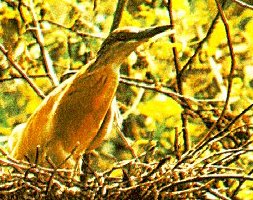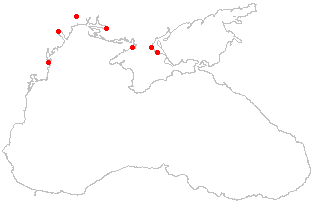 Synonyms: Ardea
ralloides.
Synonyms: Ardea
ralloides.Ardeola ralloides (Scopoli, 1769)
 Synonyms: Ardea
ralloides.
Synonyms: Ardea
ralloides.
Common names: Engl: Squacco heron; Russ: Zholtaya tzaplya; Turk: Alaca balikcil; Ukr: Zhovta chaplya, Chepura.
Order (Scientific): CICONIIFORMES.
Family (Scientific): ARDEIDAE.
Taxonomic descriptions: Ardeola ralloides is of the five species of the genus, distributed in Africa and Southern Asia. The only species that occurs in the Black Sea region.
 IUCN
Status:
IUCN
Status:
World level:
Black Sea Regional level: EN
Subregion level: EN
Distribution:
Habitats type, Critical habitats, Limiting factors: Breeds in dense reed-beds of fresh and brackish water-bodies or flooded bushes of river-valleys. Ardeola ralloides always joins other Ciconiiformes colonies, ocupying the outer ranges of them. Feeding habitats are open and half-open shallow-waters, where the Ardeola ralloides forages on insect larvae and other invertebrates.
Biology: Arrival - April-early May (usually between 13 April - 2 May). Breeding starts in mid June, sometimes late May. Hatching is in early July. Autumn migration starts early - from late August to mid September. Some birds may stay till the end of September. Breeds always colonially, together with larger herons and Plegadis falcinellus. Due to late breeding, Ardeola ralloides have to settle on the periphery of the colonies, thus increasing the risk of predation. Clutch size varies from 3 to 5 eggs, breeding success depends upon the disturbance level nearby. If not disturbed, birds usually breed successfully. The heron preys in open or slightly vegetated shallow water-bodies, watching mobile and searching for immobile food items. Its diet consists mostly of molluscs, insects and their larvae, small copepods, spiders and leeches. A rare visitor to agrocoenosis and garden-plots in the river valleys, where it may prey upon invertebrates after rains.
Population trends: Hard to estimate, since it varies in sub-regions: in some places numbers sharply decrease, whereas new colonies appear in others. It will be true to say that population "balances on the edge" and new colonies will not ensure its stability. Up-to-date estimate of population size shows fluctuations within 200-900 pairs.
Threats: Constant human disturbance, further degradation of reed-beds in some regions and river-flows pollution. Water pollution and a decrease in feeding capacity in big and small river deltas as well as disturbance of colonies are the major ones.
Conservation measures taken: Special protection of all new colonies, expansion of the preserve net-work.
Conservation measures proposed:
References:
Compiled by: J.Chernichko